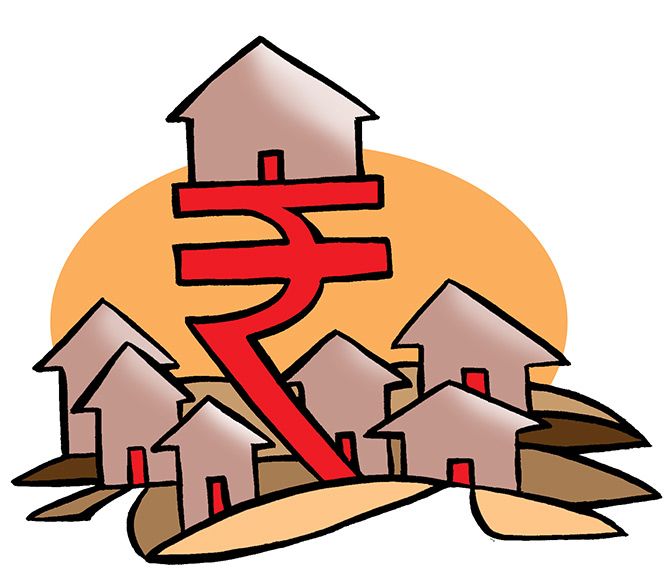'The shadow banks are currently facing a liquidity and solvency crisis.'
'The danger is that it could potentially engulf the entire financial system because shadow banks have borrowed huge amount of money from banks, mutual funds, pension funds, and insurance companies.'

"Better be safe than sorry," says economist Kavaljit Singh, director, Madhyam, a public policy research think-tank based in New Delhi, about the current crisis in India's shadow banking sector.
The author of Fixing Global Finance: A Developing Country Perspective on Global Financial Reforms and Rethinking Bilateral Investment Treaties: Critical Issues and Policy Choices blames the regulators of India's banking and financial sectors, pension funds, and mutual funds for the current mess in the sector.
"The light-touch regulatory approach allowed shadow banks to undertake unethical business practices," Singh tells Rediff.com's Prasanna D Zore in an e-mail interview.
Singh believes a financial contagion could be on its way, and to avoid which he prescribes "A complete overhaul of regulation, supervision, corporate governance, and risk management practices in the shadow banking sector."
Here's then to understanding India's shadow banking mess with Singh. The first of a two-part interview:
Could you explain for the layperson what's at the root of the crises faced by India's shadow banking sector and the 'hidden fault lines' have been exposed because of the IL&FS crisis?
The crisis in India's shadow banking sector emerged last year when Infrastructure Leasing and Financial Services (IL&FS) defaulted on payment obligations on inter-corporate deposits, bank loans, short-term deposits, and commercial papers.
The series of defaults by IL&FS had a domino effect on the entire shadow banking sector as IL&FS was the leading shadow bank in the infrastructure financing.
The lenders and investors became cautious of lending money and investing in shadow banks and started pulling their money from this sector as they realised if IL&FS -- a big shadow bank with much backing from leading national and global institutional investors -- could default, the rest of entities could also default.
Suddenly, investors started questioning the inherently flawed business models of shadow banks due to asset-liability mismatch -- shadow banks borrow short-term and lend long-term.
Unlike banks, most of them cannot raise resources directly from the public, and therefore, they are dependent on short-term wholesale funding from banks, mutual funds, insurance companies, and pensions funds.
Plus their use of excessive leverage multiplies the risks associated with asset-liability mismatches.
So it all began with default by IL&FS, but soon engulfed into a liquidity crisis affecting not just IL&FS but also other shadow banks.
Even those shadow entities having sound balance sheets also suffered due to a liquidity squeeze.
Now several months have passed after the IL&FS default, and the government has also replaced the management of IL&FS; still, there is a crisis of confidence affecting the entire sector.
Shadow banks are finding it difficult to raise new resources via equity or debt routes. Disbursements have almost stopped.
In the past few years, the shadow banking sector was booming because a lot of risky activities moved from the main banking sector to the shadow banking sector.
In particular, shadow banks which expanded their businesses rapidly when the commercial banks withdrew from infrastructure and industrial financing due to higher NPAs are more in trouble as they are unable to raise funds cheaply and the cycle of rotation of money has broken.
They cannot borrow at higher costs as it would directly affect their profitability.
At the same time, we should not miss the regulatory angle contributing to the current crisis.
The RBI and National Housing Bank lightly regulated the entire shadow banking sector. The light-touch regulatory approach allowed shadow banks to undertake unethical business practices that have come into public notice recently.
So it was a combination of factors that led to the present crisis.
Where do you see the NBFC (non-banking finance company) storm heading in terms of the systemic financial turmoil that it is likely to create (or, has already created) and its impact on the real economy?
It is difficult to predict when the ongoing crisis in the shadow banks will end, but fear of a financial contagion is still there.
The shadow banks are currently facing a liquidity and solvency crisis, and the danger is that it could potentially engulf the entire financial system because shadow banks have borrowed huge amount of money from banks, mutual funds, pension funds, and insurance companies.
Last month, the RBI came out with a financial stability report in which it estimated that the collapse of one big shadow bank would lead to a failure of one commercial bank and loss of 5.8% of Tier 1 Capital (representing a bank's capital adequacy or capital that protects depositors' interests even after absorbing losses) of the entire Indian banking system.
The financial troubles at IL&FS and Dewan Housing Finance Corporation Ltd (DHFL) are still not over.
DHFL reported a net loss of Rs 2,223 crore (Rs 22.23 billion) for the fourth quarter of 2018-2019.
Despite selling several of its equity stakes and assets to meet its debt repayment obligations, DHFL has again defaulted on commercial papers and bonds.
It is estimated that the total exposure of the mutual funds's industry to DHFL is around Rs 5,000 crore (Rs 50 billion).
Some mutual funds having exposure to DHFL have already marked down their net asset values (NAVs) to zero.
One does not know how the DHFL saga unfolds further.
There could be further troubles in some other systemically important NBFCs. Hence, the possibilities of a financial contagion cannot be ruled out at this moment.
The ongoing liquidity crisis in the shadow banking sector is having an impact on the real economy.
Look at real estate, automobiles, consumer durables, and other segments; they all are feeling the pinch.
In the case of automobiles, one is witnessing a collapse in sales of cars, two-wheelers, CVs and tractors.
Similarly, there has been a drastic cut in discretionary spending by consumers.
Low disbursements by shadow banks have also negatively affected the real estate sector as borrowing costs for property developers have increased by 100 basis points.
Close to 60% of property developers's loans are given by housing finance companies and NBFCs -- two important segments of India's shadow banking sector.
Buyers are also shying away from the real estate sector as the flow of credit has been choked due to shadow banks not having money to lend.
The real estate sector is likely to face a tough year, and it could severely affect the overall economy.
Part 2: 'In coming months, mutual fund industry will be stressed'
Main Illustration: Uttam Ghosh/Rediff.com










